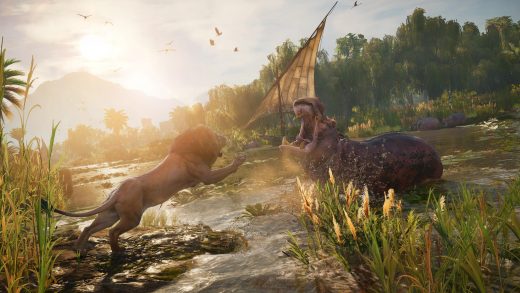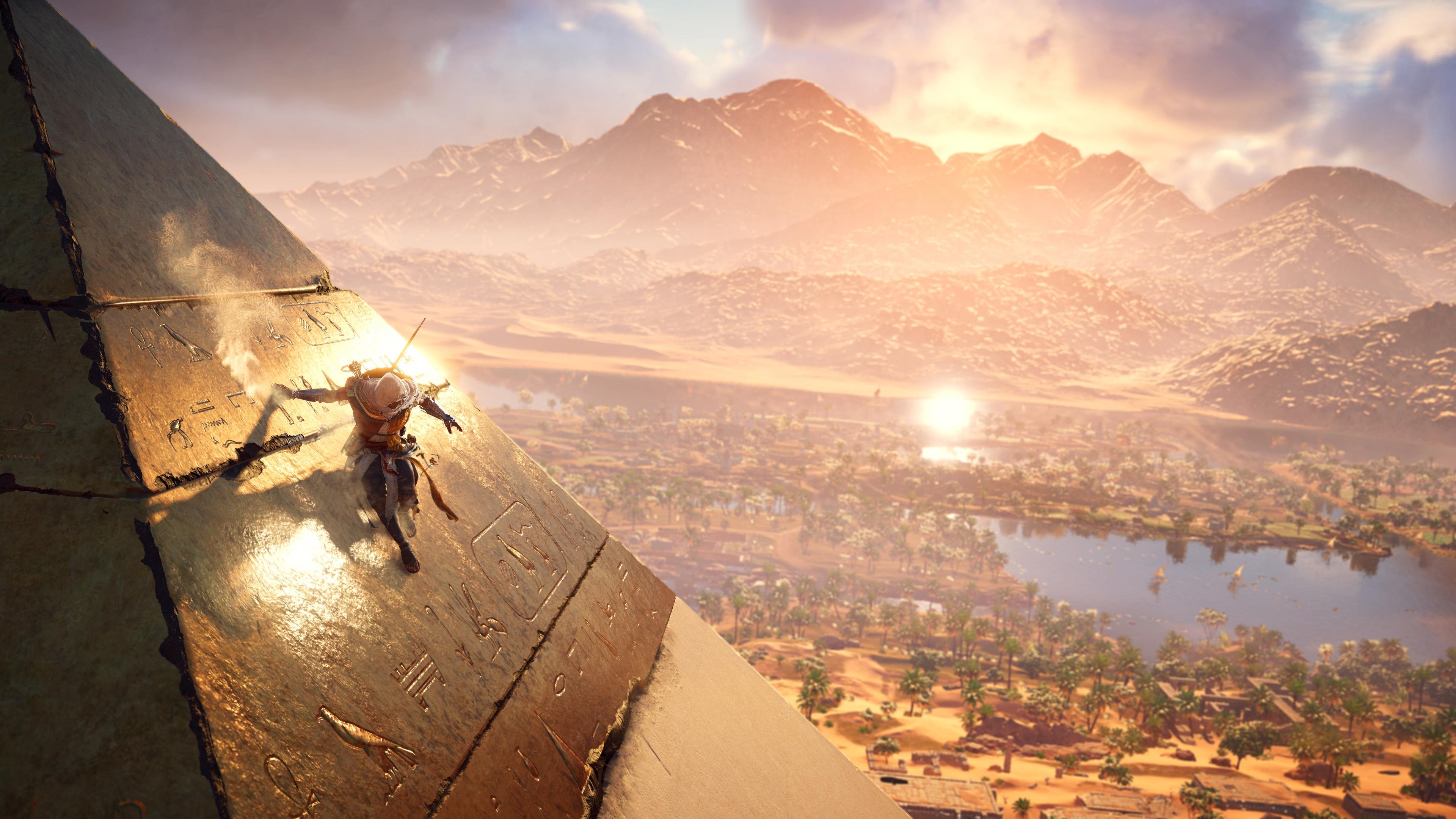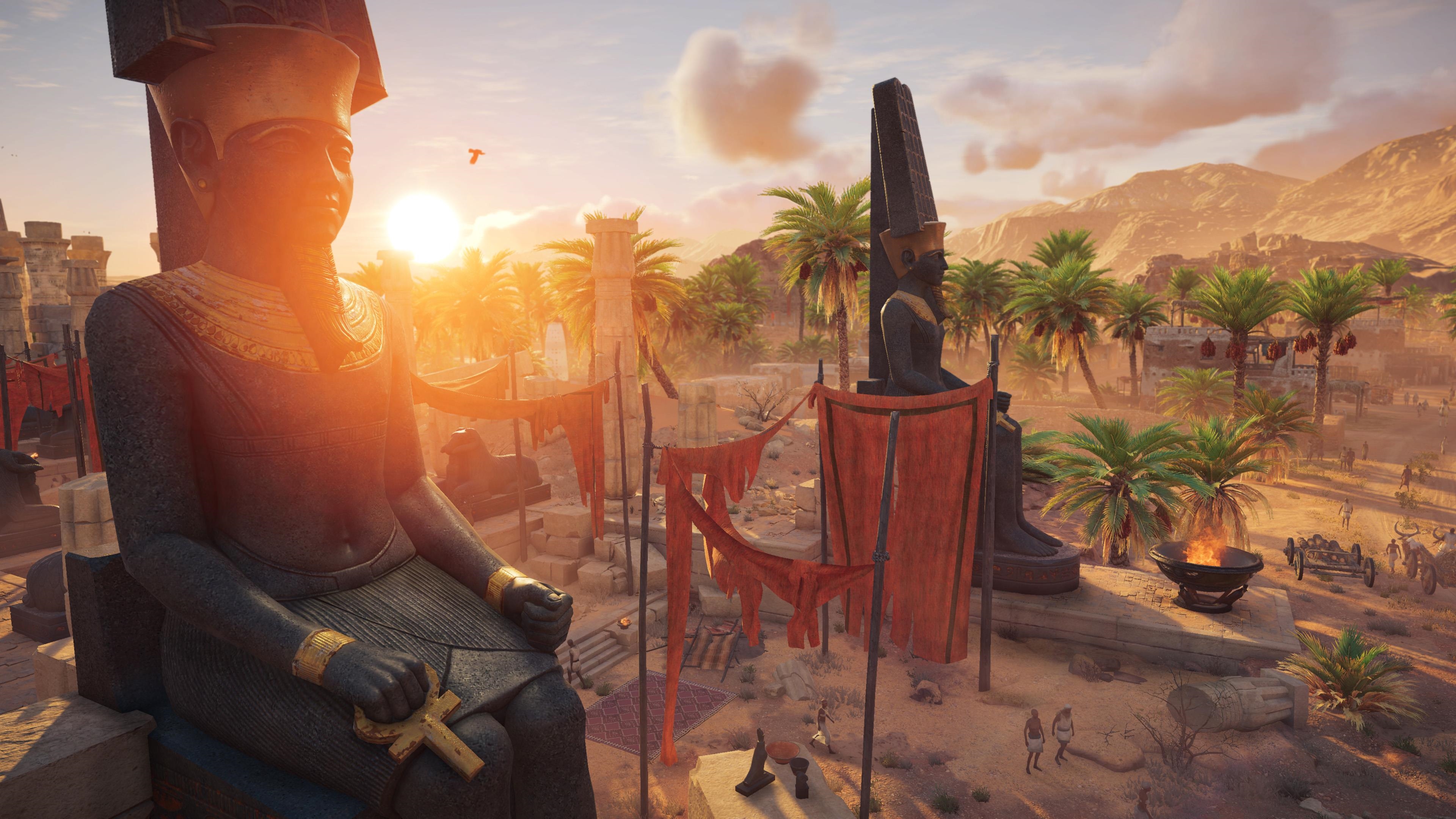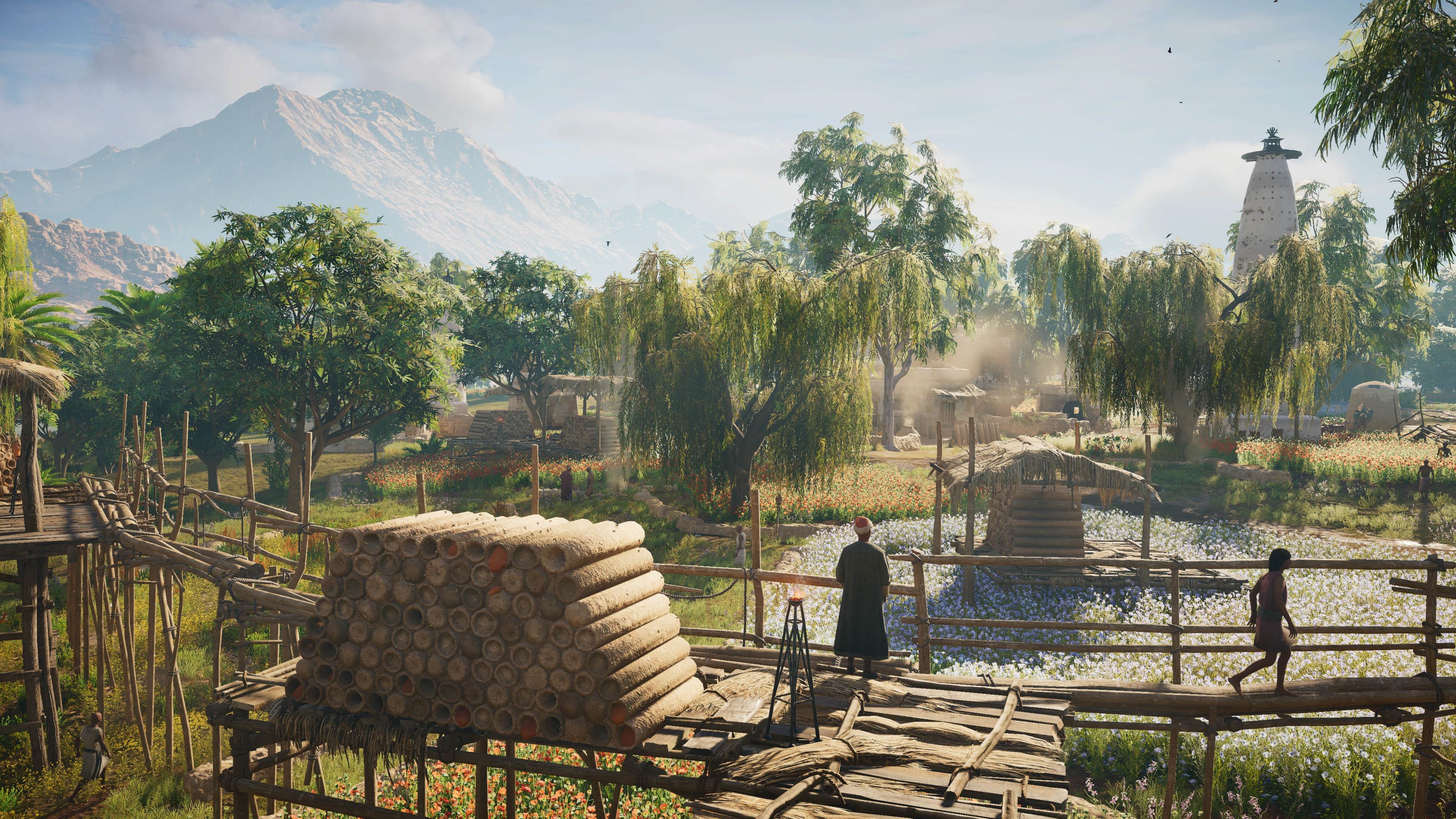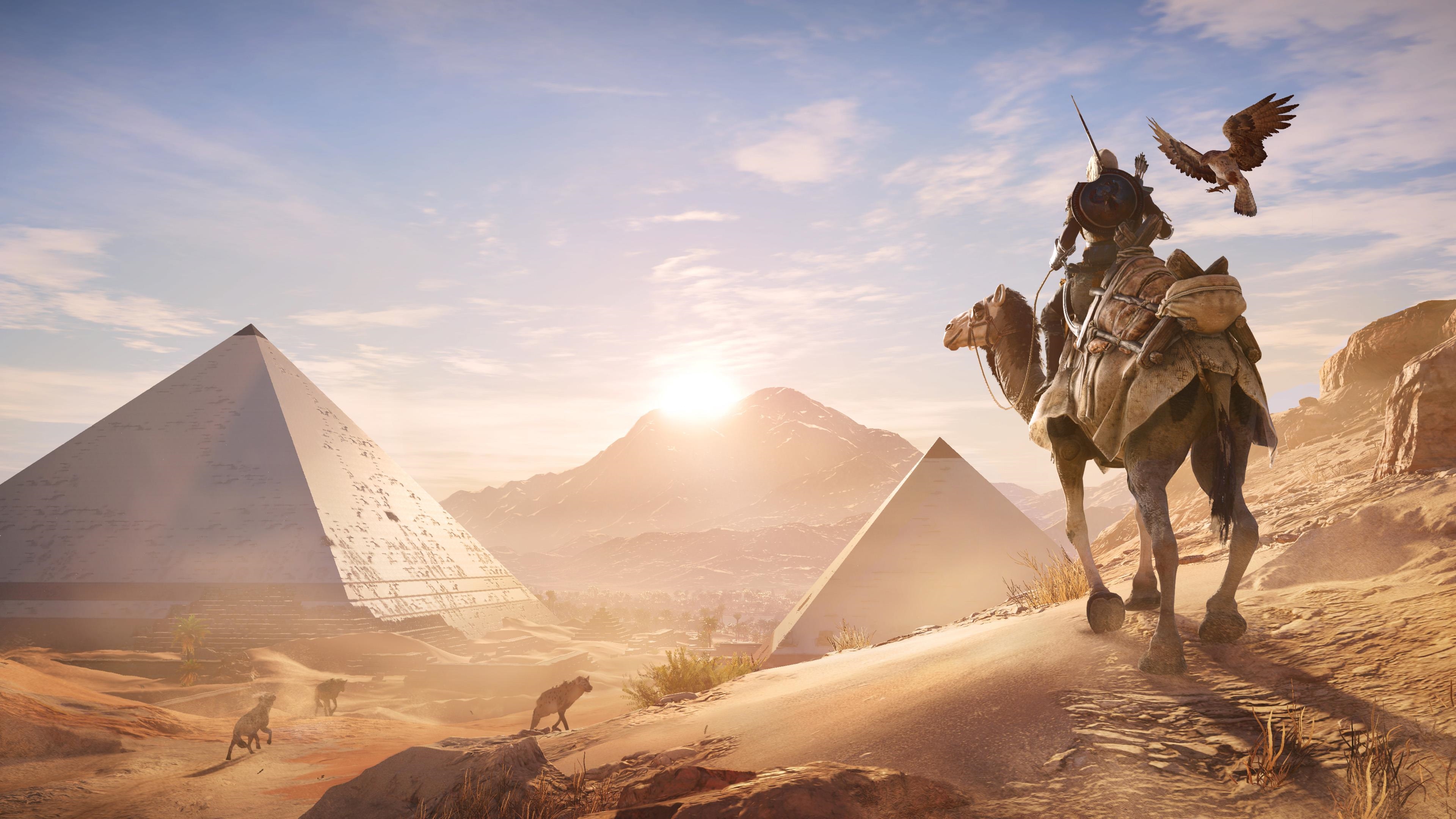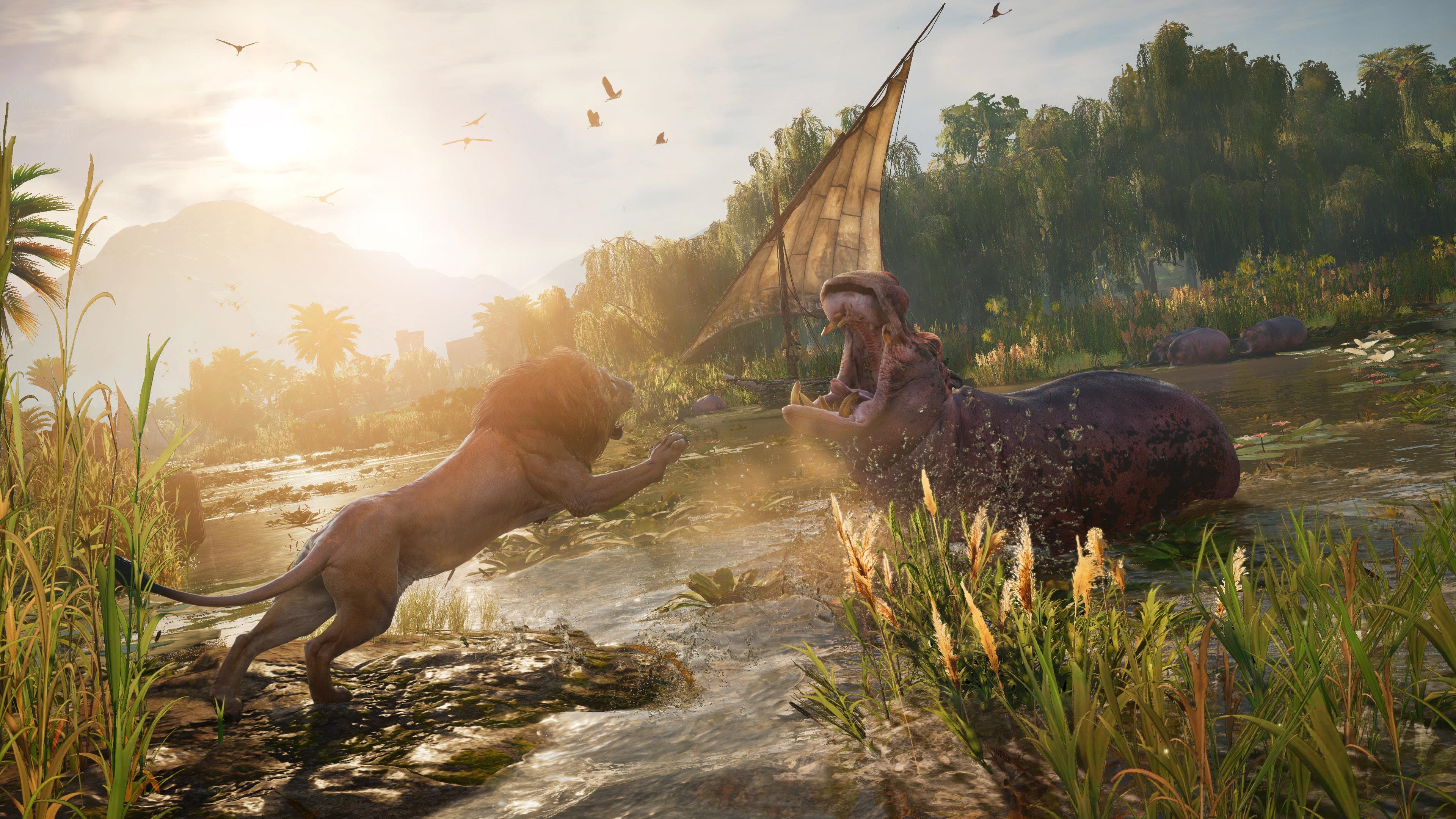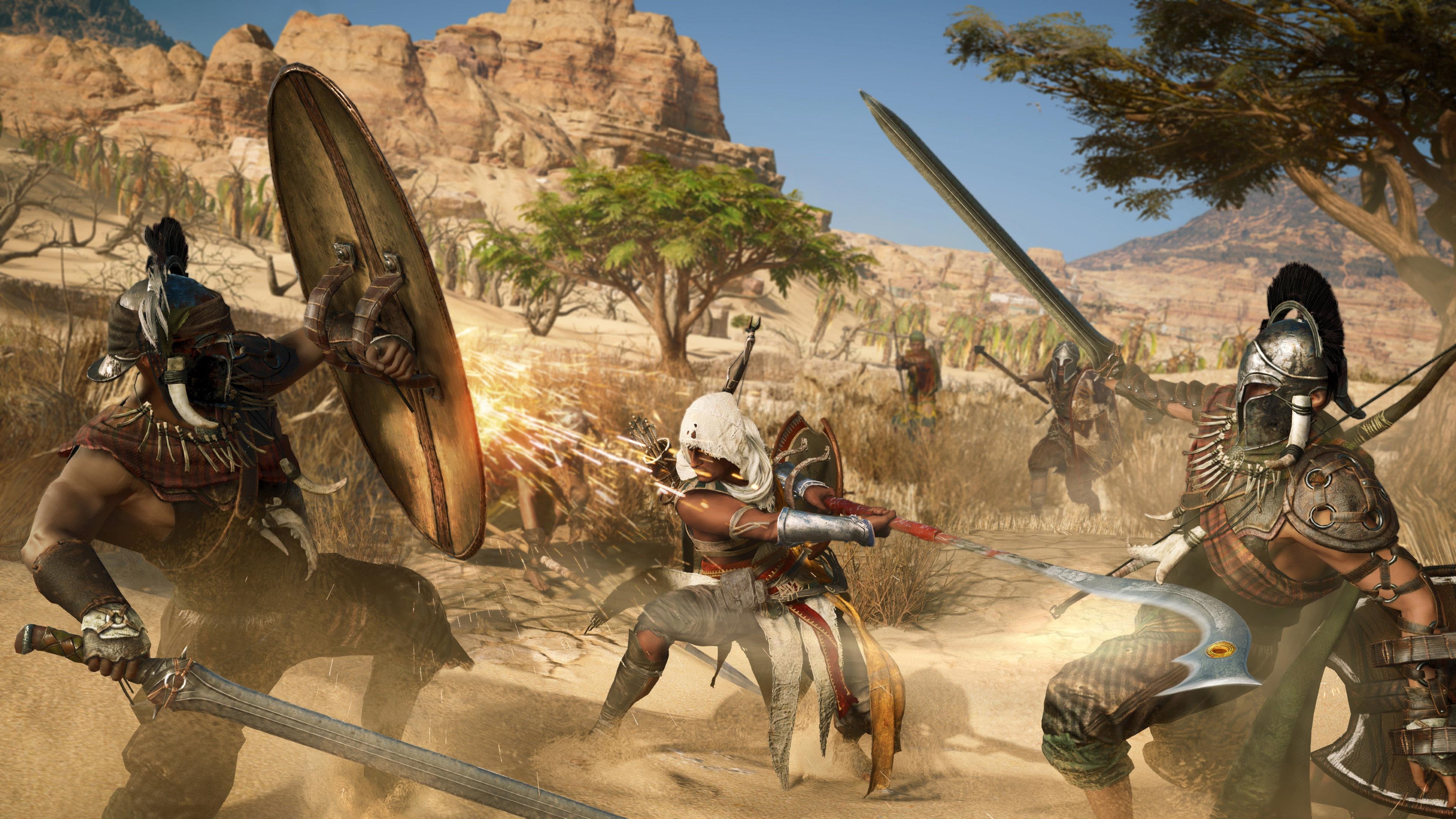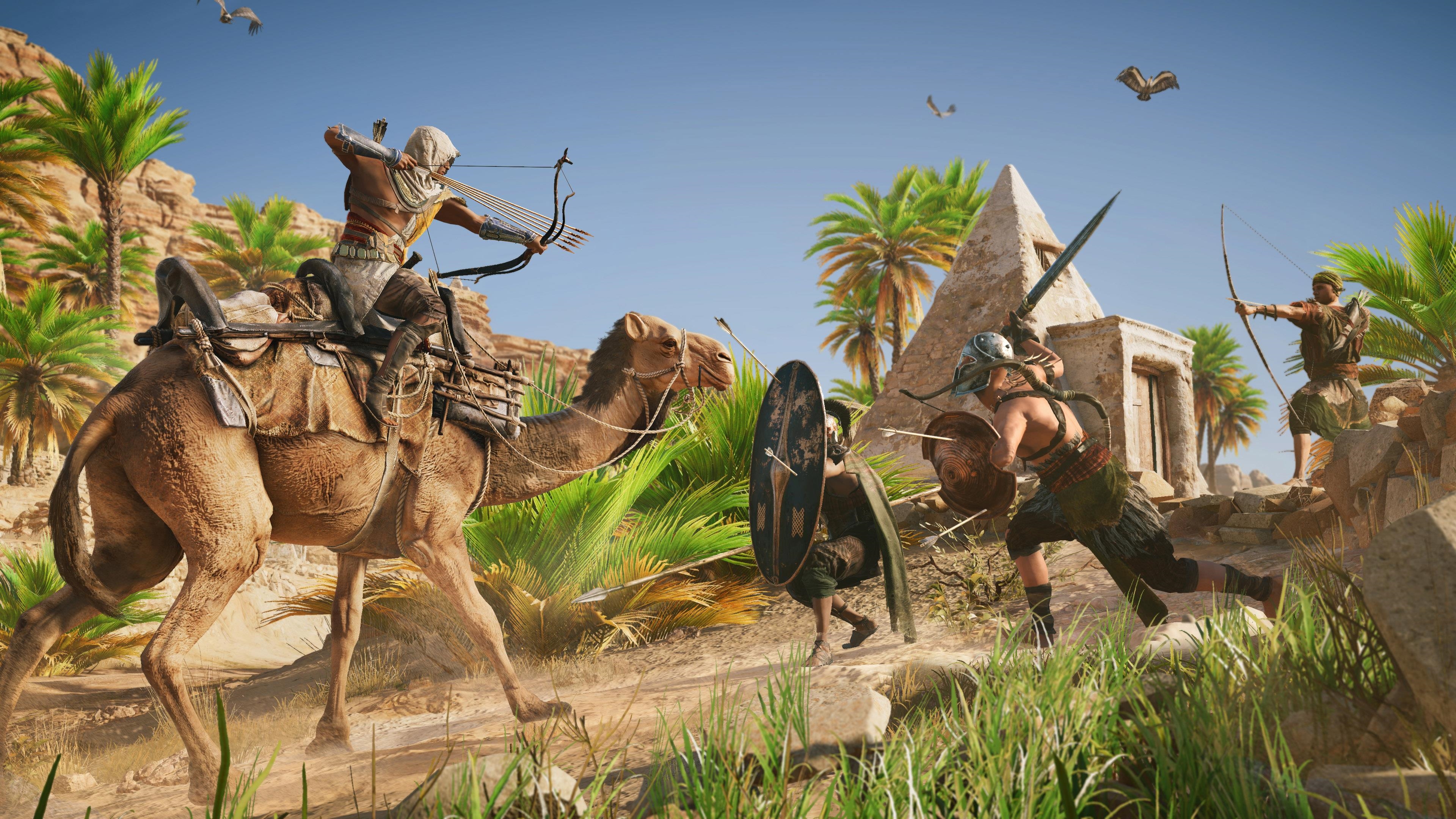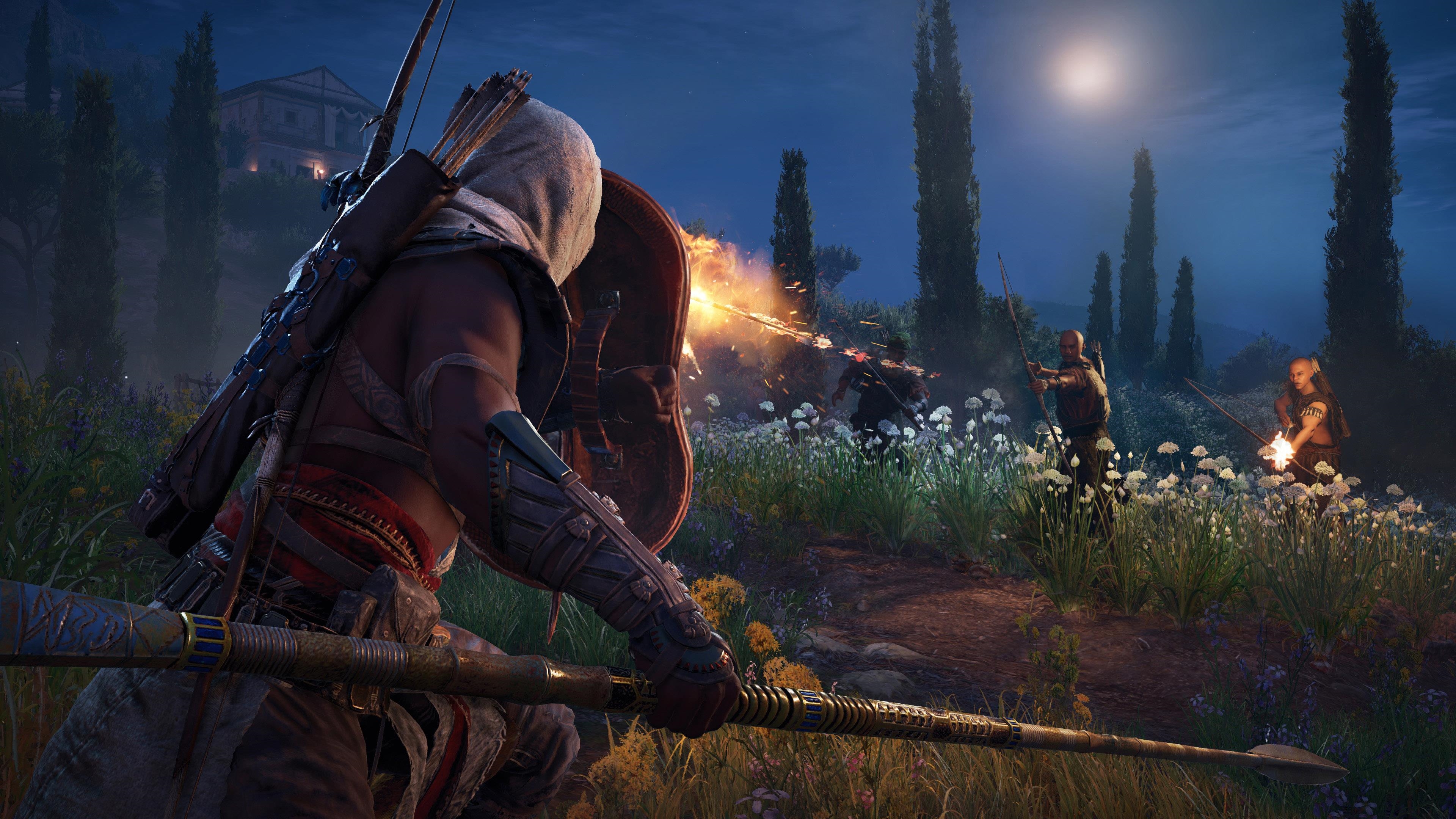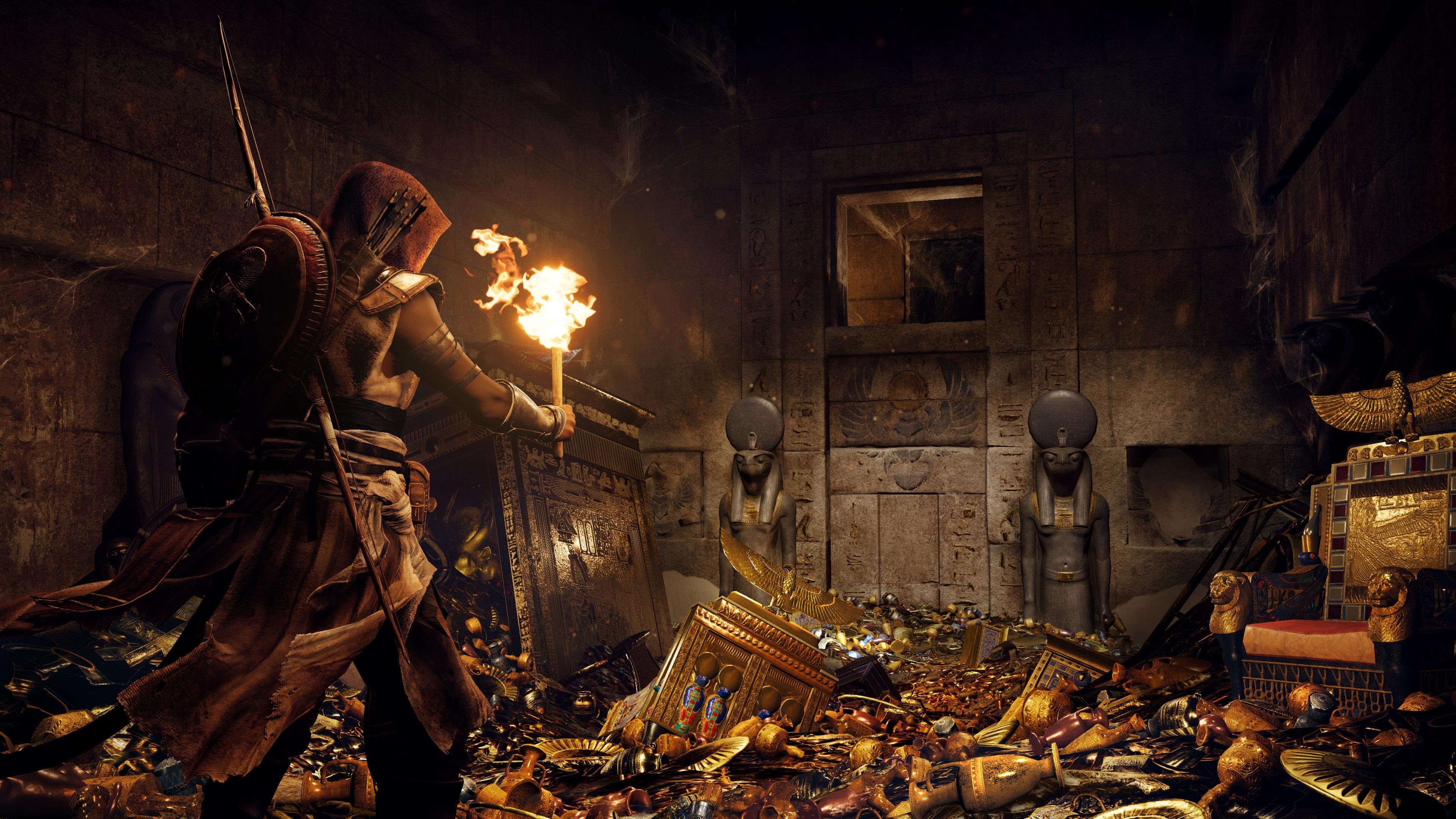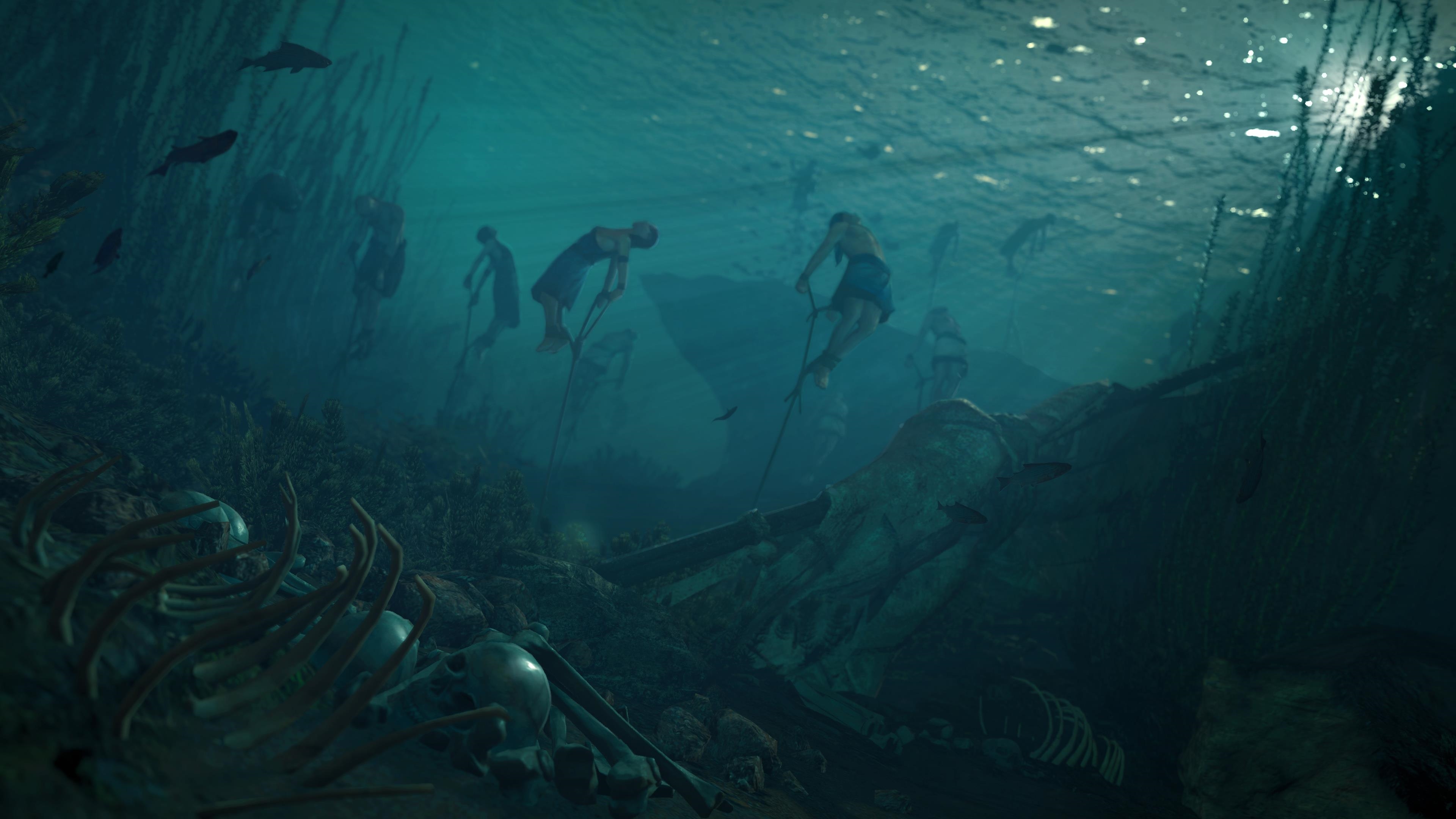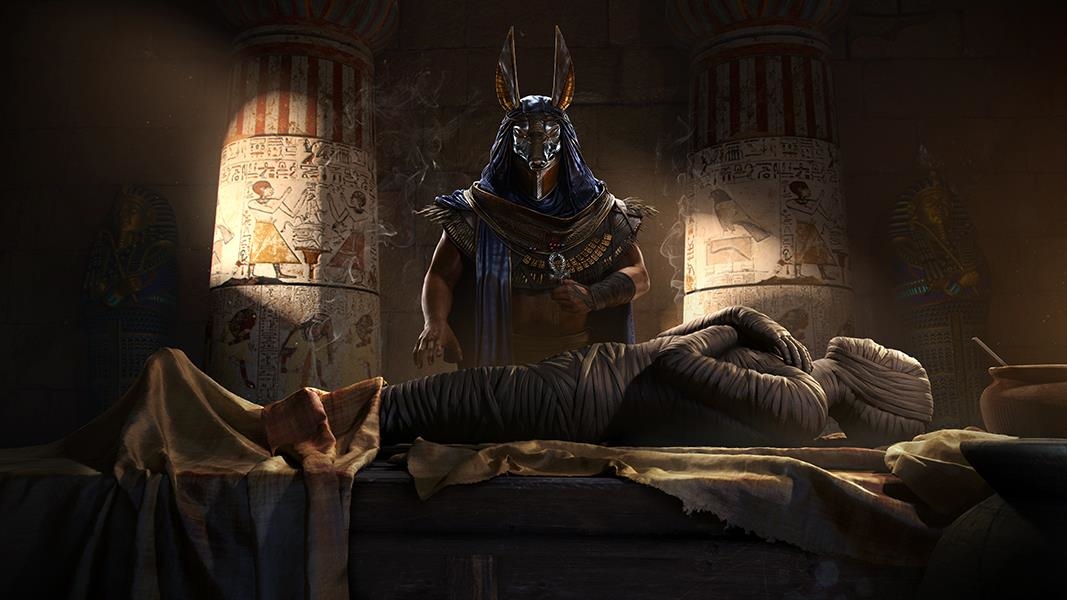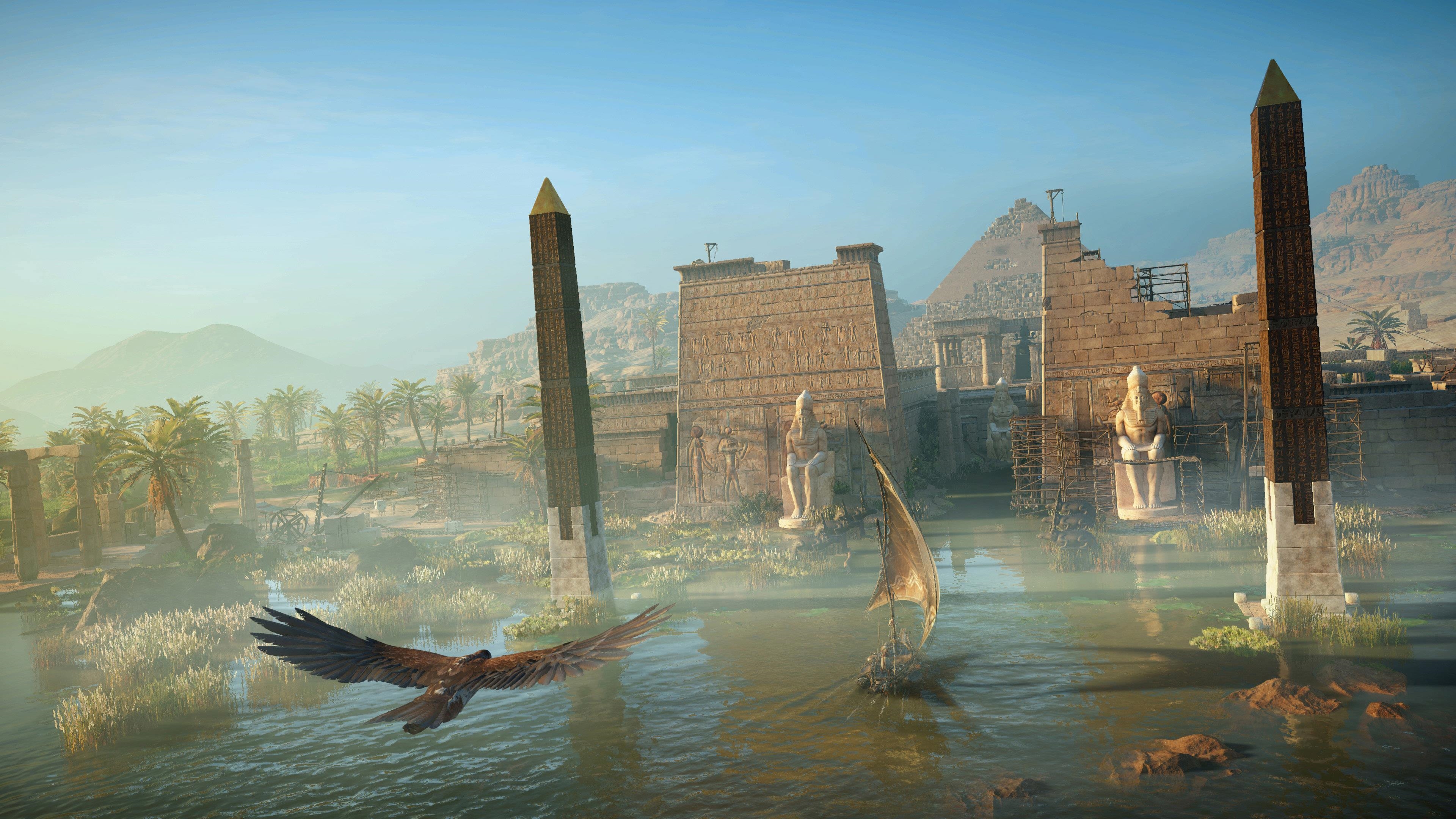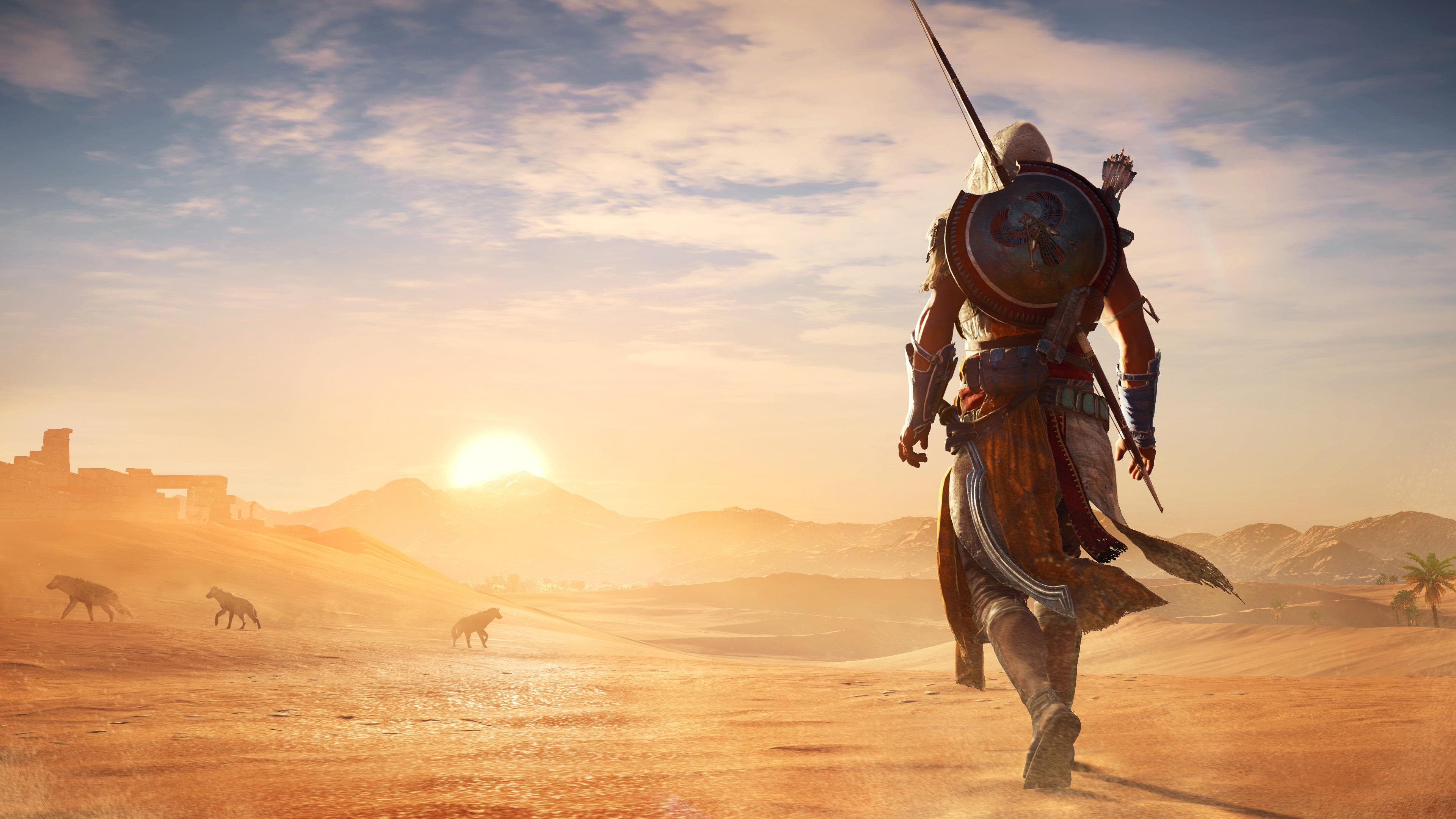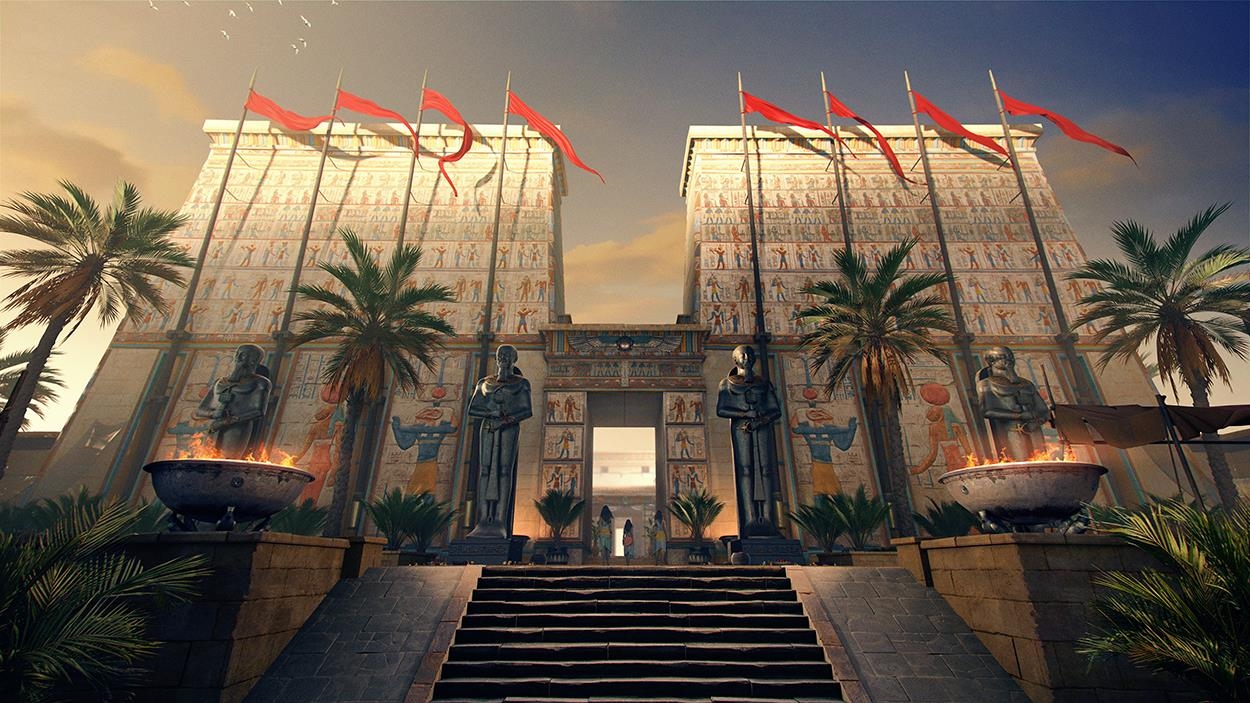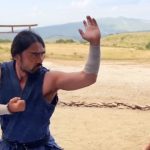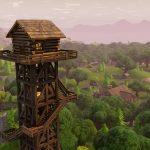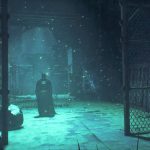Assassin’s Creed Origins – What You Need to Know About Its New Setting, New Hero, and New Action-RPG Gameplay – E3 2017
Assassin’s Creed Origins – What You Need to Know About Its New Setting, New Hero, and New Action-RPG Gameplay – E3 2017
- Setting – Welcome to Ancient Egypt
- How Combat Has Changed
- Abilities and Assassin Tricks
- A New Approach to Quests
- Discovering the Origins of the Brotherhood
Set amid the pyramids, oases, and cultural upheaval of Ancient Egypt, Assassin’s Creed Origins is the first entry in the franchise to take place earlier than its predecessors, at a time when what we now know as the Assassin Brotherhood was in its infancy.
Combat, exploration, and even the way missions are structured have all been overhauled and reinvented, creating an experience that – while unmistakably Assassin’s Creed – represents a whole new beginning for the series. Assassin’s Creed Origins is a world not of elaborate gadgets and strange technologies, but of gods, mystery, and freedom. We’ve dipped our toes into that world by freely exploring one of its regions, Faiyum, and speaking to Origins’ creators. Here’s what we’ve learned about what’s in store when Assassin’s Creed Origins is released at the launch of Xbox One X and on October 27 for Xbox One, PS4, PS4 Pro, and PC:
Welcome to Ancient Egypt
Ashraf Ismail, game director for Assassin’s Creed Origins, knows a thing or two about creating massive worlds, having previously led development of Assassin’s Creed IV: Black Flag and its vast Caribbean seascape. He and his team have taken what they learned and used it to build a huge recreation of Ancient Egypt, filled with diverse landscapes and endless activities to pursue.
“We have the capacity, from a technological standpoint, to create a massive countryside,” says Ismail. “It’s not a city, it’s a whole country with many cities, many villages, many exotic landscapes.”
“We know that people, when they think Egypt, they think desert,” says Jean Guesdon, the game’s creative director. “But Egypt is way more than that. You have the Nile Delta, you have the Nile River, you have tons of oases. So when you mix all that, from the green, lush fauna of the Nile Delta to the oasis of Faiyum, it’s the perfect playground.”
The Faiyum region is just a small part of the game’s world, and the E3 demo is set in an even smaller part of Faiyum – but even the small slice we had access to was vast and diverse, a place where desert cliffs give way to bustling towns and sprawling acres of carefully irrigated farmland. It’s home to opulent temples and mysterious Egyptian ruins, all huddled around the massive, crocodile-infested Lake Moeris. It’s a place where you can lose yourself for hours uncovering secrets, crossing swords with mercenaries, and fending off a broad assortment of deadly wildlife.
Our first glimpse of Faiyum introduced us to Bayek of Siwa, the last of a fading Egyptian military order. We begin the E3 demo (which opens at a point just shy of halfway through the game) with Bayek on horseback, riding along a desert pathway surrounded by cliffs and dune-covered hills that we’re free to scramble up for an expanded view of our surroundings. Following the path ahead leads us to a sweeping view of Lake Moeris and its surrounding towns. Two pharaonic statues stand sentry over the entrance to the valley; as we’ll soon learn, they’re already relics of an ancient culture that’s starting to fade under the Ptolemies, a Greek dynasty that has overseen centuries of occupation and rule.
“Egyptian history spans thousands of years,” says Maxime Durand, the development team’s resident historian. “Egypt’s civilization began about 3,000 years before the game’s era, and Ptolemaic Egypt is this period of about 300 years.”
Faiyum’s landscape feels lived-in. To the south of Moeris is Euhemeria, where a stately villa is surrounded by weathered, poor-looking dwellings that get poorer the closer we get to the docks. Following the roads out of the town center leads us past market stalls and into the farmlands of Dionysias, where acres of farms and (highly flammable) straw huts make for a strong contrast against cloth-draped Greek pavilions and a huge stone temple dedicated to the crocodile god Sobek (outside of which we watched a religious procession, complete with a ceremonial boat carried by the marchers).
“The NPCs of the world have full schedules, day and night,” says Ismail. “The NPCs are living a life in this world which includes working, sleeping, socializing, eating, peeing, and so on. Farmers farm, priests run rituals and prayers, bandits ambush and steal, Ptolemaic guards patrol, defend, transport and so on. All of this is based on their day/night cycle, and as you learn more about the world and the specific characters you meet, you can play with where to meet them, assassinate, attack, steal, infiltrate, and so on.”
Head out beyond Dionysias and you’ll come to the desert, where goats roam among hyenas, cobras, and camel-riding bandits. There are pockets of civilization amid the dunes, as well as harder-to-find points of interest that hold a unique allure for Bayek.
It’s worth noting that Viewpoints are still dotted across the map, waiting for you to climb and sync with them, although their functionality is a little different from previous games. In the demo, they aren’t necessary for revealing the map, but synchronizing unlocks them as fast-travel spots, while also marking potential quests and other points of interest as question marks.
If fast travel is too fast for your liking, Bayek can get around quickly using horses, camels, and even chariots, which can be purchased from stables and summoned at any time with a whistle. Better still, these don’t need your constant input to get around; if you’d like your mount to move on autopilot, you can command it to follow the road and then nudge it when you reach a fork. Stables are just one of four types of shops, too; you’ll also be able to visit blacksmiths for a continually updated selection of weapons and shields, weavers for new outfits, and bazaars for rare loot and mystery crates (which you can earn through daily quests).
The real jewel of Faiyum is Lake Moeris itself. Its shores are dotted with feluccas, tiny fishing vessels that can blaze across the lake at high speeds without consideration for wind. Fishermen will sometimes steer their feluccas out to you if you’re stuck swimming in the middle of the lake, and they’ll then sit quietly at the bow while you commandeer their boats. The larger vessels that patrol the lake tend to be much less friendly, crewed with mercenaries who might blithely ram your boat to pieces even before they spot you and open fire. So it’s nice to be able to pay them back by sneaking aboard, dropping the lot of them with Bayek’s Hidden Blade, and stealing any loot that isn’t nailed down.
To find what makes Moeris special, however, you’ll need to dive under its relatively calm surface. For the first time, Assassin’s Creed Origins seamlessly integrates underwater exploration with the rest of its world, letting you freely dive wrecks and underwater ruins in search of loot. Some of the highlights of Moeris include the sunken Temple of Pnepheros, marked by a Sobek statue jutting out of the water, and a shipwreck containing golden treasures key to one of the demo’s missions. Both are a great opportunity to use Bayek’s Animus Pulse ability, a wave that highlights loot items and other points of interest with briefly flickering sparks.
Assassin’s Creed Origins seamlessly integrates underwater exploration with the rest of its world.
Whether you’re diving for treasure or just going for a swim, wildlife is a constant concern. Moeris is home to teeming populations of hippos and crocodiles, both of which will aggressively attack fishing boats, each other, and you, if they spot you. Fortunately, Bayek is more than a match for them, thanks in part to a combat system that’s more flexible than ever before.
How Combat Has Changed
Bayek is an extraordinary man, one who possesses abilities unlike any Assassin to date. Chief among these is his approach to battle; where previous Assassin’s Creed fights revolved largely around dispatching small crowds with a system of instant-kill counters, Bayek’s tactics are more direct and aggressive. His melee approach centers on combo strikes, dodges, and deflections, and he can annihilate foes from a distance with ranged weapons or use stealth to topple them one after another. In a toe-to-toe fight, enemies will coordinate in merciless ways, lunging in or firing arrows while you’re busy slashing up their comrades, so the dodge button frequently comes in handy. Bayek can also block attacks with his shield so long as you’re standing still, or you can use it to briefly knock enemies off-balance with an unlockable parry move. It’s even possible to drop smoke bombs mid-combo, which is great for when you’re feeling overwhelmed and need a little breathing room.
“The philosophy around the combat is different, but so are the controls,” says Ashraf Ismail. “The default controls propose a very different experience compared to previous Assassin’s Creeds, but fit very well with the new combat system. For people who really miss the legacy controls, we will have options to change the default. Otherwise, in terms of gameplay, it is really about learning each weapon and how they behave – because there is a lot of depth there – and also paying attention to the weapons wielded by enemies, as this will dictate their behavior.”
Able to lock on and quickly switch focus between enemies, Bayek can unleash flurries of light attacks that are enough to take down most weaker enemies, and his slower, heavier strikes can knock aside shields and stagger foes. Bayek also has an adrenaline gauge at the bottom of the screen that builds up during combat; depending on your weapon, filling it will let you unleash either a devastating, defense-smashing Overpower attack that’s more than enough to kill most enemies, or a frenzy that briefly makes Bayek stronger, faster, and more resistant to damage.
“The fun aspect of this is that you can use one weapon to build your adrenaline quickly, switch to another weapon, and unleash the Overpower action,” says Ismail. “This allows for some fun pairing of melee weapons.”
At the start of the Faiyum demo, Bayek had a bronze khopesh – a sickle-like Egyptian sword – as well as an iron spear that sacrificed destructive power for reach. New weapons of varying rarity are scattered around the open world as loot, and a little poking around in fortified mercenary camps produced new swords, shields, paired daggers, heavy maces, and more, each of which opened up new fighting styles to keep enemies guessing. The full list of weapon categories, according to Ismail, consists of regular swords, sickle swords, dual blades, heavy clubs, heavy blades, scepters, and spears, and Bayek can also fight bare-handed. You can amass a sizable collection of gear for different purposes, and eventually unlock quick-swap slots that let you switch between two melee weapons or bows without heading into the inventory screen.
A well-aimed shot can break open the cages of captive lions or hyenas to create a deadly distraction.
“Some weapons are more effective against certain enemies,” says Ismail. “For example, with shielded enemies, it is better to use heavy weapons, as they break a shield defense more efficiently. But for enemies that dodge quickly, landing a hit with a heavy weapon is very difficult. Having a weapon with range is more efficient for those enemies.”
If you don’t feel like going toe-to-toe with your enemies, new bow types are also in abundant supply around the world. The standard hunter’s bow is more or less what you might expect: an accurate weapon that lets you draw back and fire arrows into distant, often unsuspecting foes. And while that’s great for long-range engagements, Bayek can build up a huge collection of bows with radically different functions and uses.
If you’re stuck in the middle of a close engagement with multiple foes, for example, you might want a warrior bow, which fires five arrows at once in a shotgun-like spread pattern; or a light bow, which rapidly shoots five arrows in quick succession with no need to draw back the string. There’s also the predator bow, an ideal weapon for snipers, which comes with a super-accurate first-person viewfinder, fires instantly with no pullback, and carries an unlockable ability that lets Bayek control its arrows in flight.
“We’ve worked very hard to make sure that players can quickly switch between bows and melee efficiently, without big camera movements,” says Ismail. “Players will learn that bows have a strong value in melee. For example, a fully charged hunter bow shot will break a shield defense and knock an enemy to the ground. Being quick with the light bow will allow players to do some damage to an enemy who has a shield up and charging you. And a full shot from the warrior bow will knock anybody to the ground!”
If you prefer a more indirect approach, a well-aimed shot can break open the cages of captive lions or hyenas to create a deadly distraction. Your arrows can also be lit on fire if you’re near a blaze, which is great for igniting the red pots of oil stockpiled throughout the world – to say nothing of small enemy boats, which can catch ablaze quickly and collapse under their occupants (who will then attempt to swim to other boats and continue the fight).
Mastering Bayek’s weapons and abilities is essential if you plan to tackle another of Origins’ new additions: boss fights against formidable warriors and strange creatures. We played through one of these, set in an arena in the city of Krokodilopolis, in which Bayek faced down a hulking man known as the Slaver. His weapon of choice was (appropriately enough) a man catcher, a spiked, forked polearm that he used to grab Bayek and hurl him around the arena, frequently into rotating spike traps.
An Assassin’s Tricks
Bayek is more than a warrior – he’s an Assassin, and as such he has an assortment of tools and abilities that set him apart on the battlefield. His Hidden Blade is one of these, and it’ll be one of several persistent items – including a health-enhancing breastplate, a damage-boosting bracer, and more – that Bayek will need to upgrade over the course of his journey.
“Bayek starts the game with most of his basic gear except for the Hidden Blade,” says Ashraf Ismail. “All his gear starts at level 1 and levels up through crafting, which increases the stats of the gear and its appearance. The Hidden Blade is found by going through the story, and it is necessary to keep upgrading if you want to maintain the ability to perform assassinations. Otherwise, you do stealth damage and enter combat.”
Speaking of stealth, it can be a little easier to sneak around fortified encampments at night, when visibility is low and some of the guards are sleeping. And if you don’t feel like waiting around, you can fast-forward through the day by making Bayek meditate until nightfall.
“More often, you have guards who sleep at night,” says Ismail. “But the counter to this is that you also have more bandits active at night, so you can be ambushed or attacked if you are not wary of such things.”
In the demo, Bayek carries a handful of sleep darts, which can knock enemies out for a few crucial seconds, giving you a window for a fatal stab or a quick escape. Eventually, you’ll even be able to use them as a crucial step in taming animals – including crocodiles, hippos, lions, and more – who’ll loyally follow Bayek into battle and obey his commands until they die. And that’s just for starters; Bayek’s repertoire of tools can be expanded over time to include firebombs, poison clouds, traps, and much more.
These abilities are unlocked through a skill tree that’s divided into three categories: Hunter, Warrior, and Seer, each of which reflect a different style of play and cover different functions.
“We want players to have fun finding their own way through the ability graph,” says Ismail. “The Hunter path is made to lean towards ranged fighters and stealth players. Warrior is obviously made for melee fighters, and the Seer path is for playing with manipulation – Assassin tools, economic persuasiveness, animal taming, etc.”
Bayek also has what seems to be an inexhaustible supply of torches, which can light his way through dark places. They also have another, more sinister use: he can throw them to light certain materials on fire, torching straw huts and setting oil slicks ablaze. And if you don’t mind taking a bit of burning damage in the name of showmanship, you can add a dash of daredevil panache to your Leaps of Faith by tossing a lit torch into a waiting hay bale and diving in after it.
“Aside from watching things burn and doing damage, fire is also a distraction,” says Ismail. “Guards will investigate fires and try to put them out. Major fires will make people flee! It’s a tool that is useful in stealth.”
Quests and A New Kind of Adventure
The key to discovering what Assassin’s Creed Origins has to offer is Senu, Bayek’s eagle and the origin of the phrase “Eagle Vision.” Instead of the color-coded second sight of later Assassins, Bayek can send Senu aloft to get a bird’s-eye view of the landscape. Not only that, but unlockable abilities let her tag patrolling threats so that Bayek can easily spot them, or distract enemies by lunging down at them from the sky.
She can also pinpoint nearby objectives, which is especially important because Assassin’s Creed Origins does away with the traditional onscreen minimap entirely, instead relying on floating onscreen markers that point you in the general direction of tasks you need to complete.
“We didn’t want to hold players’ hands,” Jean Guesdon says. “This is why we decided to remove the minimap. We want you to enjoy and to actually experience the beautiful world we’re bringing to you. You will have to play the game to put icons [on the map].”
The markers you do get aren’t always exact, which is part of the fun. Our very first task in the demo was to find Hotephres, a Greek informant who sailed across Moeris on a ship that carried a statue. We knew generally where he’d be, but rather than sail across the massive lake in search of a single large boat, we loosed Senu. When she got close, a yellow awareness indicator appeared, at which point we parked her in midair and scanned her surroundings until a tightening yellow circle clicked shut on Hotephres’ ship.
“We didn’t want to hold players’ hands. This is why we decided to remove the minimap. We want you to enjoy and to actually experience the beautiful world we’re bringing to you.” – Jean Guesdon, Creative Director
More than an extra step in finding a mission objective, this exercise underlined Assassin’s Creed Origins’ new approach to the structure of its quests. Rather than being locked into a clear chain of A-to-B story beats, you’ll take a free-form approach to discovering your objectives, and you can pursue them more or less at your leisure. After visiting Hotephres, for example, we were tasked with visiting his wife, Khenut, who held a ledger pointing to the identity of a sinister figure known as The Crocodile. However, talking to one of Hotephres’ deckhands also revealed rumors about farmers in Dionysias, who were dying as their fields were burned by unknown assailants.
At that point – or at any other point where a passerby told us about something that could lead to a mission – we were free to track and pursue either objective. You won’t run into a mission failure or desynchronization if you wander off the “correct” path; we could even go so far as to wander away from one quest mid-mission, tackle the other one, and then return to where we’d left off in the first quest. This flexibility also means there’s a considerable degree of freedom in how you approach your quests; there’s just the objective, the environment, and threats to avoid or dispatch as you see fit.
The Origins of the Brotherhood
As the title suggests, Assassin’s Creed Origins isn’t just about taking a step back in time to see how ancient Assassins took down their targets. Bayek is the last of the Medjay, a Nubian order of warriors who served as agents of the pharaohs for hundreds of years, protecting cities and temples from threats. In his hometown of Siwa, Bayek is seen as a hero – but in the rest of Egypt, where the influence of the Greek Ptolemies is stronger, those in power seem to view him as more of an inconvenient relic.
“At the time of Bayek, the Medjay didn’t have a reason to exist anymore, because the rulers were not pharaohs,” says Maxime Durand. “There were new people that replaced the Medjay.”
Bayek is steadfast in his mission, believing that the gods of Egypt support him, but even he sees the need to adapt to the pressures of an ever-expanding world. Those adaptations form the basis for many of Assassin’s Creed’s familiar symbols.
“Was it just that someone decided ‘I’m going to put on a hood?’” asks Ashraf Ismail. “No, no. There are stories behind all of this, and these are the experiences you explore in the game.”
Assassin’s Creed Origins will be released at the launch of Xbox One X and on October 27 for Xbox One, PS4, PS4 Pro, and PC, and will be playable in the Ubisoft booth during E3 2017. For more on the game and the rest of Ubisoft’s E3 lineup, keep a close eye on UbiBlog.
The post Assassin’s Creed Origins – What You Need to Know About Its New Setting, New Hero, and New Action-RPG Gameplay – E3 2017 appeared first on UbiBlog – Ubisoft®.
(73)

